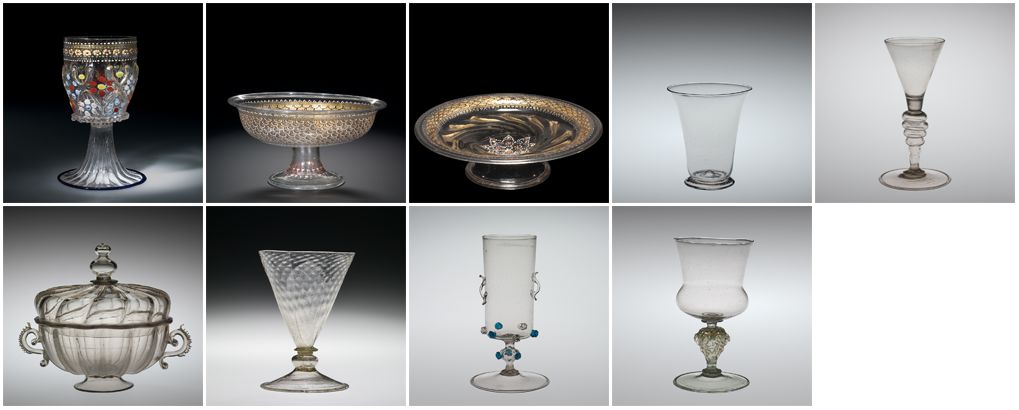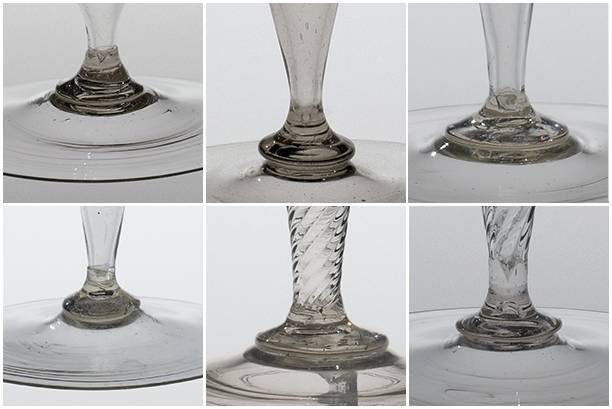A Comparison of Earlier and Later Venetian Glass
Comparative Table of Differences Between Earlier and Later Venetian Glass Vessels
The technical similarities between earlier and later objects almost overwhelm our ability to detect differences. Aesthetic contrasts aside (it is often easy to identify a piece of Venetian glass from across the room as early or late), there are usually some telling technical disparities. The following table lists a number of these. They can be useful in helping to sort out, in an organized way, physical characteristics that may indicate an object’s origin as earlier or later.
For further explanation of this table and the two main eras of Venetian glassworking, please see previous page: A Question of Continuity.
Glass Color
Renaissance
Never completely colorless; slight to moderate intensities of gray, amber, pink, etc.
19th Century
Sometimes nearly colorless; often somewhat intensely and uniformly colored gray, amber, smoke, etc.
Large Areas Covered in Highly Dispersed Surface Gold
Renaissance
Very rare
19th Century
Very common
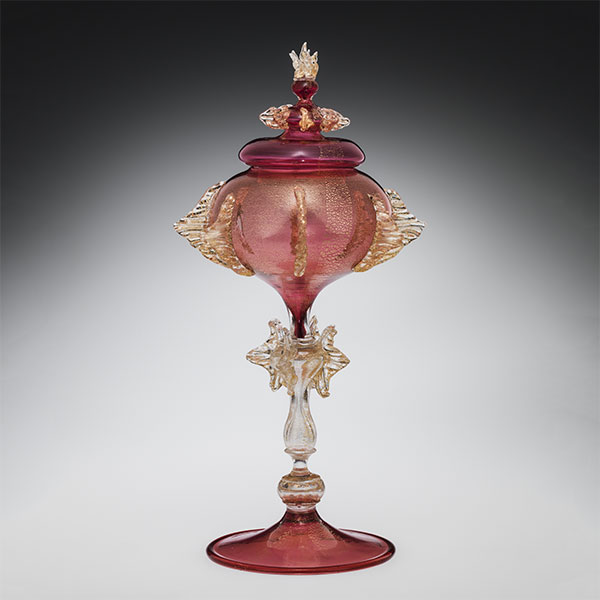
An example of disbursed gold covering most of the blown surfaces of a Venetian object made after 1860. The Corning Museum of Glass (62.3.118).
Iridescence
Renaissance
Always a result of aging
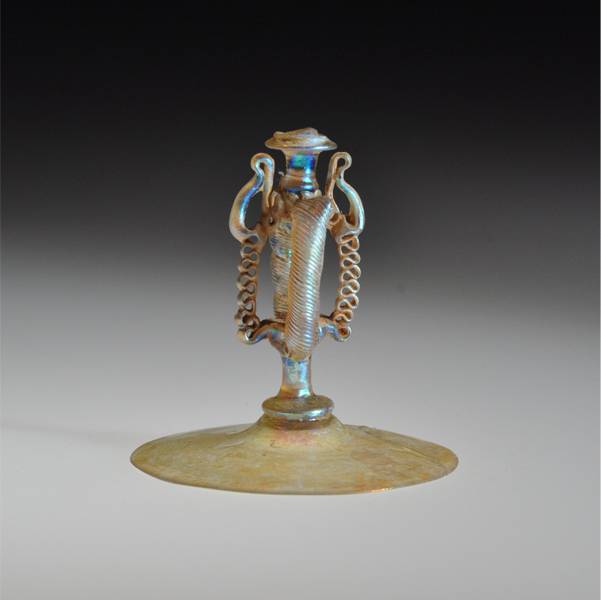
An example of iridescence resulting from the long-term burial of a 17th-century façon de Venise goblet fragment. Probably Low Countries. Private collection.
19th Century
Often created artificially for decorative purposes
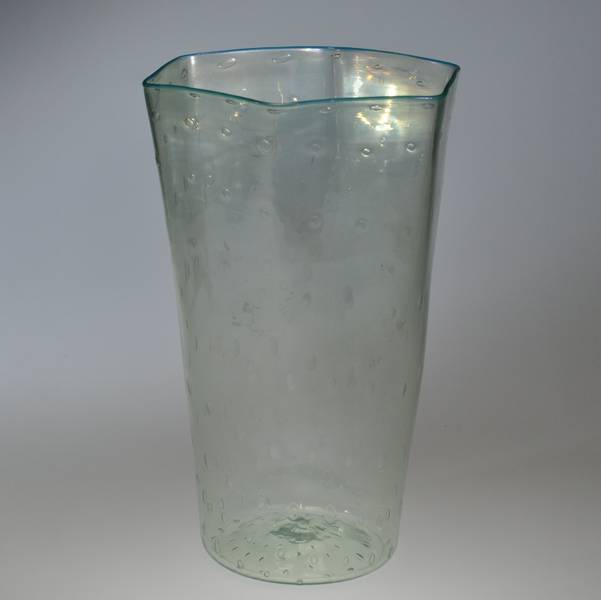
An example of iridescence resulting from chemicals (stannous chloride?) having been sprayed on the hot glass during the last stages of manufacture. Made after 1860. Private collection.
Glass Thickness/Object's Weight
Renaissance
19th Century
Objects are never of extreme thinness or lightness

A selection of later Venetian goblets, illustrating a pattern of heavier weight. Private collection.
Typical Construction Practice
Renaissance
Objects were built on the blowpipe (rare exceptions include multi-part dragon-stem goblets, for example)
19th Century
Objects were built from prefabricated parts joined with well-disguised “glue bits”
Number of Punty Marks and Location(s)
Renaissance
One possible location (with the rarest exceptions): centered on the foot’s lower surface
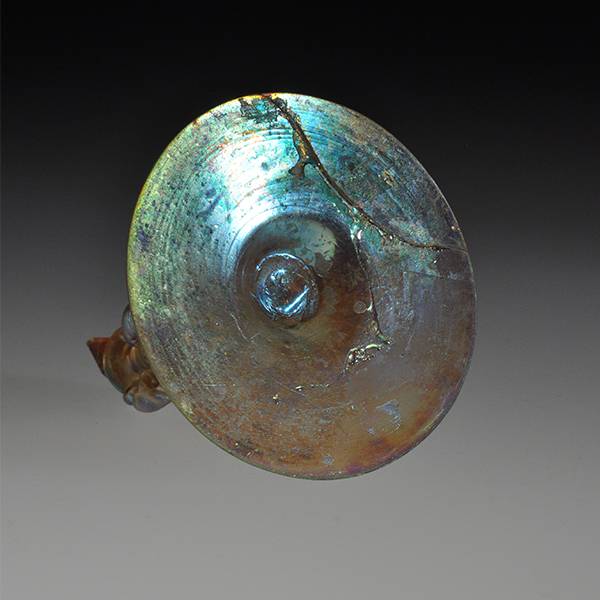
Lower surface of the foot of a 16th-century goblet, showing a typical punty mark. Private Collection.
19th Century
Often two punty marks in two different locations: one centered on the foot’s lower surface, and the other (lighter, smaller) centered inside the cup. The typical 19th century and later process that results in paired punty-marks on one object can be seen in the above video: 'Later Goblet Building Process'.
Type of Punty Mark
Renaissance
One single, well-centered, circular scar

Lower surface of the foot of a 16th-century goblet, showing a typical punty mark. Private Collection.
19th Century
Sometimes a “crown-type” punty mark: a circle of four or more tiny scars
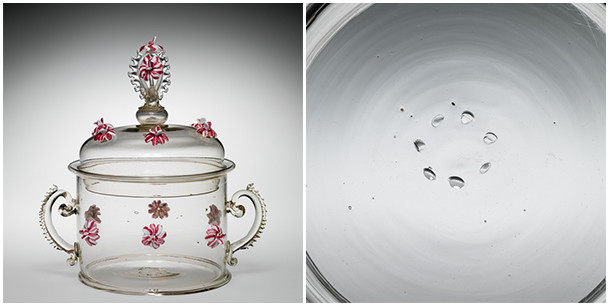
Crown-type punty mark on a Venetian object made after 1860. The Corning Museum of Glass (73.3.440).
“Start/Stop” Tool Marks on Cup and Foot
Renaissance
Almost invariably present
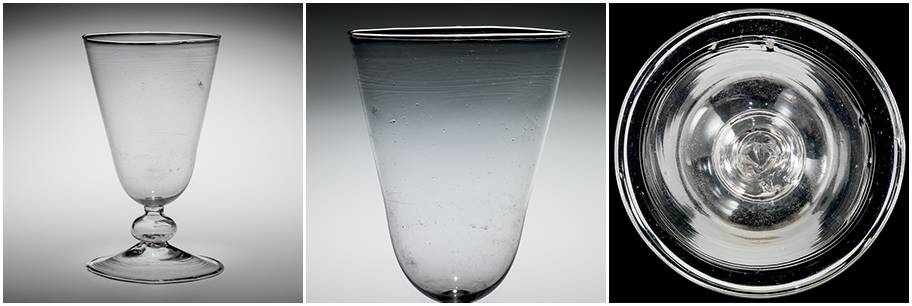
Venetian goblet made in the 16th or 17th century, showing “start/stop” tool marks. (These are very difficult to see in photographs). The Corning Museum of Glass (67.3.48).
19th Century
Seldom present
Lower Stem Profile
Renaissance
Never increases in diameter in the region where the stem joins the lower merese (never a “chicken leg” shape)
19th Century
Often/usually increases in diameter in the region where the stem joins the lower merese (often a “chicken leg” shape)
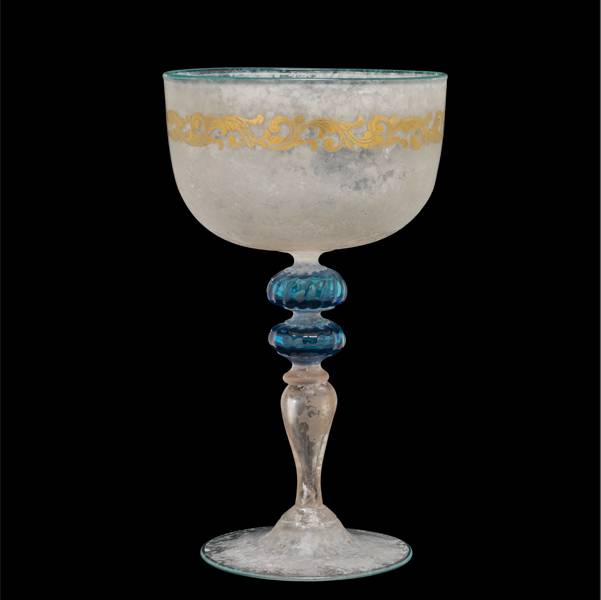
Venetian goblet made after 1860, showing increase in wall thickness of lowermost stem, where the diameter is reduced; also showing “chicken-leg” form of stem, and attachment of foot to edge of merese. The Corning Museum of Glass (93.3.61).
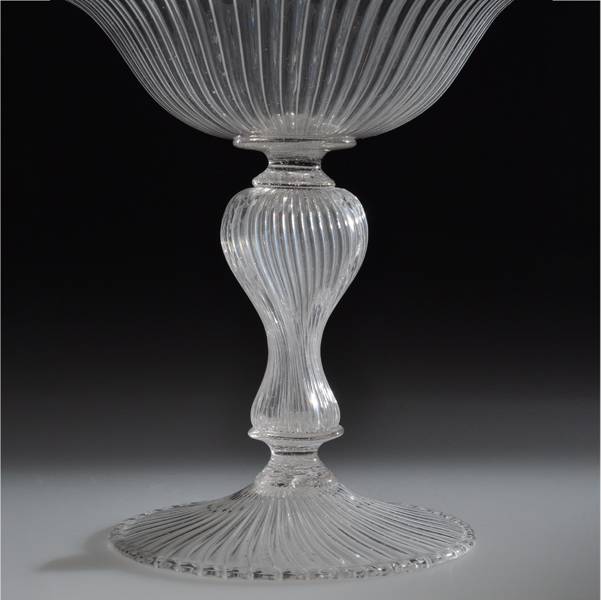
Venetian goblet made after 1860, showing increase in wall thickness of lowermost stem, where the diameter is reduced; also showing “chicken-leg” form of stem, and attachment of foot to edge of merese. Private collection.
Lower Stem Wall Thickness Variations
Renaissance
In almost all cases, there is little variation in wall thickness
19th Century
In almost all cases, the wall thickness of the stem varies with its diameter: the smaller the diameter, the thicker the wall

Venetian goblet made after 1860, showing increase in wall thickness of lowermost stem, where the diameter is reduced; also showing “chicken-leg” form of stem, and attachment of foot to edge of merese. The Corning Museum of Glass (93.3.61).

Venetian goblet made after 1860, showing increase in wall thickness of lowermost stem, where the diameter is reduced; also showing “chicken-leg” form of stem, and attachment of foot to edge of merese. Private collection.

Venetian goblet made after 1860, showing increase in wall thickness of lowermost stem, where the diameter is reduced; also showing “chicken-leg” form of stem, and attachment of foot to edge of merese. The Corning Museum of Glass (66.3.64).
Presence (or Absence) of Merese at Bottom of Stem
Renaissance
19th Century
Often absent
Shape of Merese at Bottom of Stem
Renaissance
Usually has a tubular upper portion to better grip the stem; merese is often sculpted to enhance the form of the stem
19th Century
Usually localized at the tip of the stem; usually purely functional in appearance

Venetian goblet made after 1860, showing increase in wall thickness of lowermost stem, where the diameter is reduced; also showing “chicken-leg” form of stem, and attachment of foot to edge of merese. The Corning Museum of Glass (66.3.64).
Appearance of Join Where Foot and Merese Connect
Renaissance
The foot contacts only a portion of the merese: a substantial groove is usually present between these two parts
19th Century
The foot fully envelops the entire merese: only a tiny groove is visible between the two parts

Venetian goblet made after 1860, showing increase in wall thickness of lowermost stem, where the diameter is reduced; also showing “chicken-leg” form of stem, and attachment of foot to edge of merese. Private collection.

Venetian goblet made after 1860, showing increase in wall thickness of lowermost stem, where the diameter is reduced; also showing “chicken-leg” form of stem, and attachment of foot to edge of merese. The Corning Museum of Glass (66.3.64).
Presence (or Absence) of Deep, Gouging Tool Marks on Foot’s Lower Surface
Renaissance
Almost invariably present
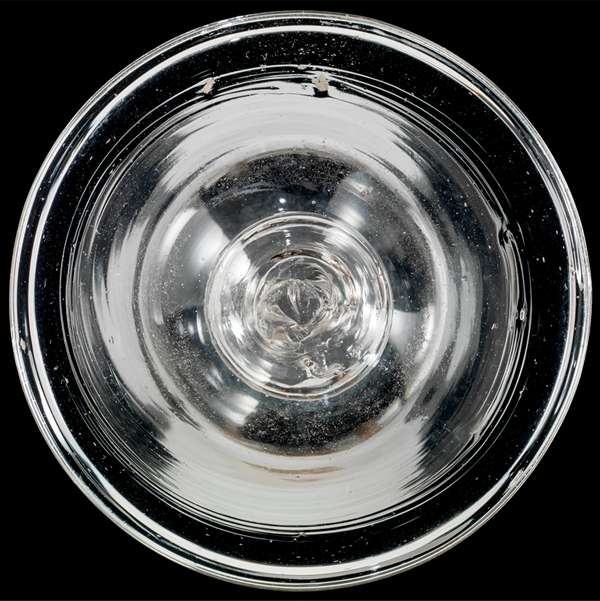
Lower surface of foot of 16th-century Venetian goblet, showing “deep, gouging” tool marks. The Corning Museum of Glass (67.3.48).
19th Century
Seldom present
Mezza-Stampatura
Renaissance
Between the two layers of glass, blisterlike bubbles are usually present
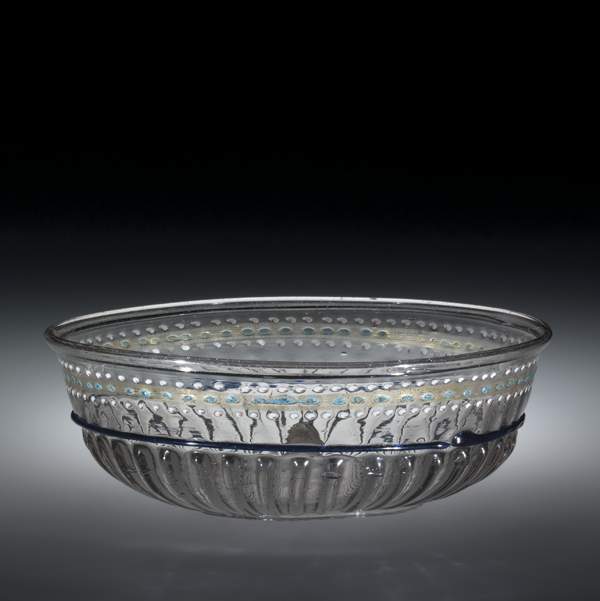
Venetian bowl of about 1500, showing multiple elongated blister-type bubbles between two gathers of glass in mezza-stampatura decoration. The Corning Museum of Glass (60.3.2).
19th Century
Bubbles between the two layers of glass are rare
Bit Work (Morise)
Renaissance
Shear marks are smoothed by fire polishing; some types of decoration have cast-off trails (best detected by touch)
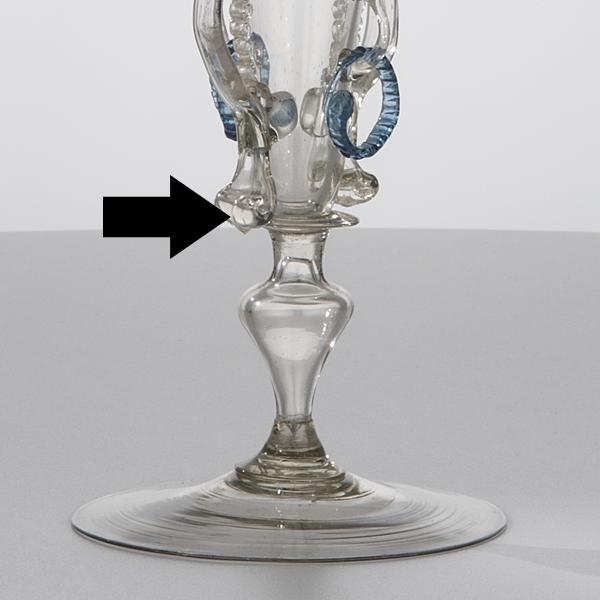
Venetian goblet of the 16th or 17th century with “chain and scroll” decoration and “early,” smooth, fire-polished shear marks at lowermost parts of scrolls (see arrow). The Corning Museum of Glass (79.3.212).
19th Century
Shear marks are rough and can be sharp (best detected by touch); cast-off trails are almost never seen
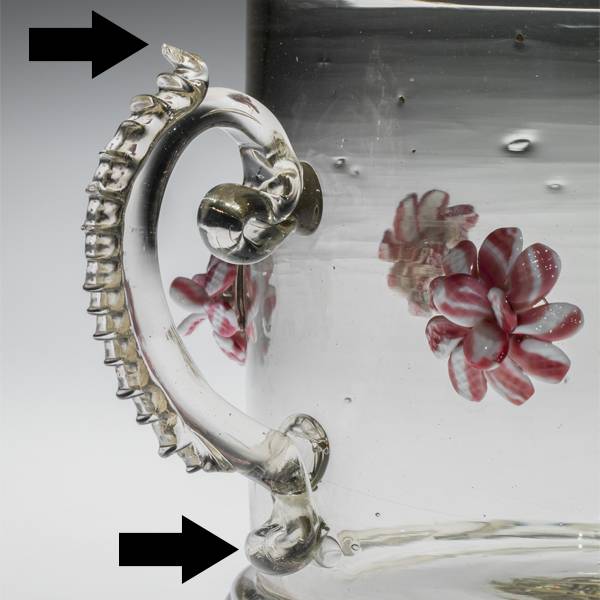
Venetian object, made after 1860, having “late,” sharp shear marks at lowermost part of handles, as well as at uppermost part of pincered decoration atop handles (see arrows). The Corning Museum of Glass (73.3.440).
Chain and Scroll–Type Decoration
Renaissance
The glass is always flat and ribbonlike

Venetian goblet of the 16th or 17th century with “chain and scroll” decoration, showing that all parts of this construction are flat and ribbonlike. The Corning Museum of Glass (79.3.212).
19th Century
The glass is often round in cross section
Filigrana Canes
Renaissance
Canes invariably have a colorless glass core (best viewed at broken edges of fragments)
19th Century
Canes invariably have a colored glass core (best viewed at broken edges of fragments)
Enameled Objects
Renaissance
Objects show one or more “symptoms” of an “on the pontil” firing process (illustrated below).

Footed platter with gently twisted mezza-stampatura , enameling, and gold-leaf decoration. Venice, late 15th to early 16th centuries. D. 26.3 cm. The Corning Museum of Glass (51.3.117).
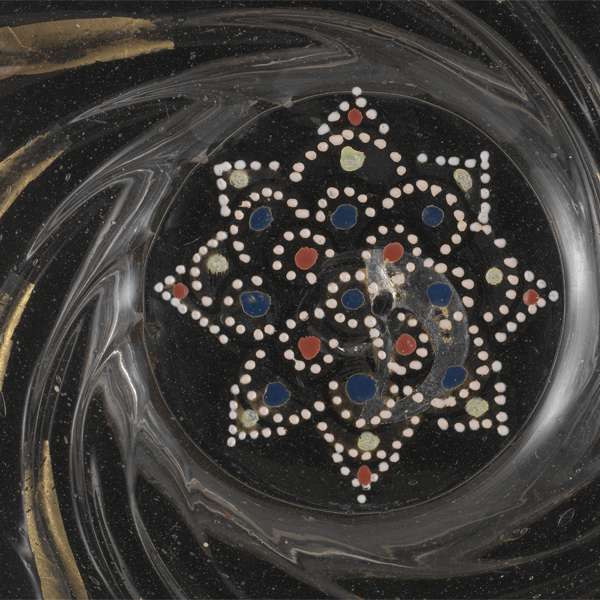
Bottom of platter, showing gold-leaf and dot pattern in center, which sharply contrasts with decoration near rim; double pontil mark is also visible. The Corning Museum of Glass (51.3.117).
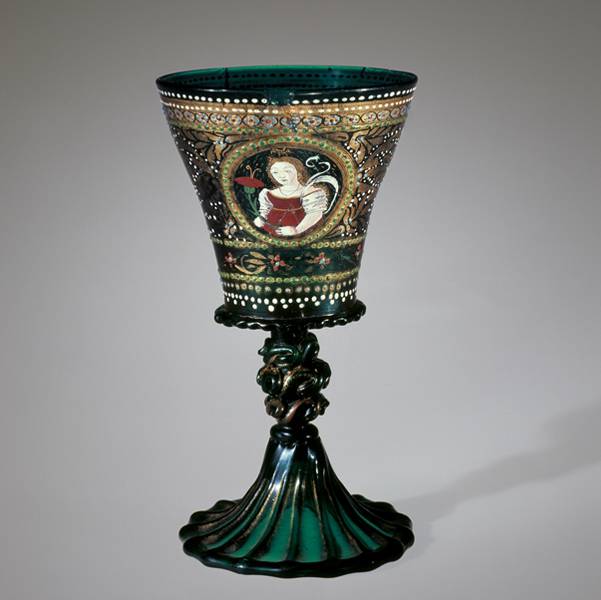
Nuptial goblet with polychrome enameled and gold-leaf decoration. The slight elongation of the enamel dots and the subtle, radially oriented breaking up of the gold-leaf decoration near the rim indicate that the diameter of the upper part of the object was slightly expanded when it was fired. Venice, late 15th century. H. 19.9 cm. The Corning Museum of Glass (79.3.170, bequest of Jerome Strauss).

Detail of goblet, showing double pontil mark on bottom (apex of foot). The second (or firing) pontil mark covers the lower three-quarters of the first mark, which was produced when the blank was made. The Corning Museum of Glass (79.3.170, bequest of Jerome Strauss).
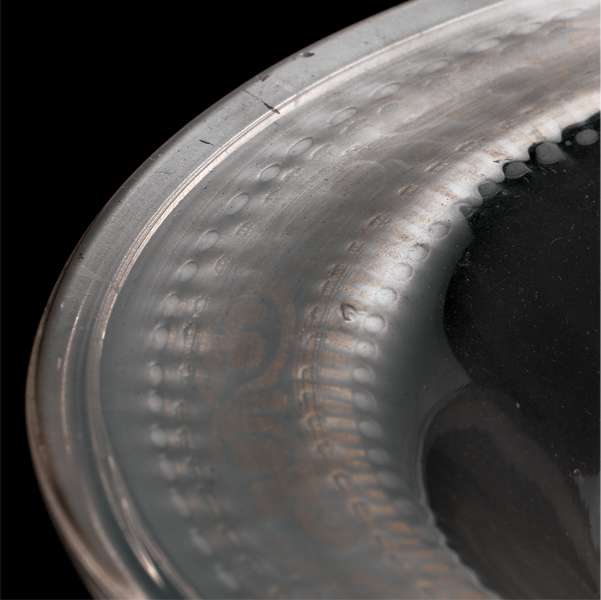
Detail showing upper, undecorated surface of enameled plate with gold-leaf decoration. The surface irregularities correspond to the presence or absence of enameled dots on the other side, indicating significant and prolonged softening of the vessel wall during the firing process (the rim area is similar to that of the footed platter shown in Figure 68a). Venice, late 15th to early 16th centuries. D. 24.1 cm. The Corning Museum of Glass (54.3.244).

Conical footed beaker with polychrome enameled and gold-leaf decoration, viewed at the level of the rim. The areas with the greatest concentrations of enamel have produced localized thickening of the vessel wall that, in turn, resulted in the downward movement of the rim above them. Venice, late 15th to early 16th centuries. H. 13.3 cm. The Corning Museum of Glass (79.3.191, bequest of Jerome Strauss).
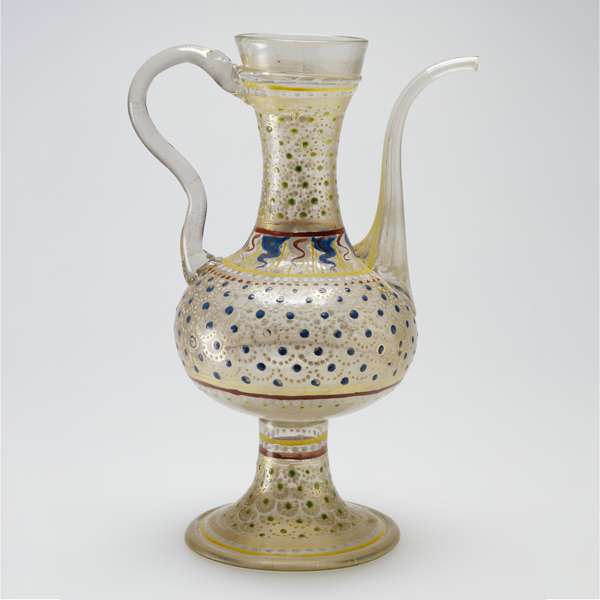
Ewer with polychrome enameled and gold-leaf decoration. The handle at both the lower and upper attachment points sits atop the still clearly visible decoration. During the formation of the spout, the addition of molten glass re-softened the wall and its decoration was drawn out, striating the enamel dots. Venice, late 15th or early 16th century. H. 27.2 cm. The J. Paul Getty Museum, Los Angeles (84.DK.512). Photo: © J. Paul Getty Trust.
19th Century
Objects seldom show “symptoms” of an “on the pontil” firing process (there are rare exceptions)

Group of replicas (some of which may have been intended as forgeries) and objects imitating historical styles, decorated with polychrome enamels, gold leaf, and gold paint. None of these objects exhibits any evidence that the decoration was fired in a furnace while the piece was reattached to a pontil. A distinctly different process, and one that was only recently possible, was employed here. The decoration was fired while these objects sat in a kiln. H. (tallest) 41.1 cm. The Corning Museum of Glass (79.3.850, bequest of Jerome Strauss; 78.3.16, gift of Mr. and Mrs. Arthur Appleton; 66.3.13, gift in part of Edwin J. Beinecke; 96.3.13; and 79.3.339, gift of The Ruth Bryan Strauss Memorial Foundation).
